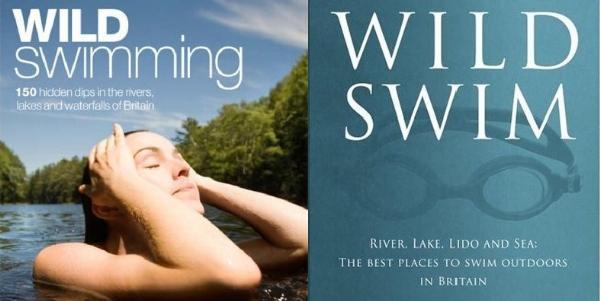![]()
“Paradise”, for Gerard Manley Hopkins as a young man studying at Stonyhurst, was to be found on the nearby River Hodder. It was not through an other-worldly dimension but a river swimming spot in which Stonyhurst students plunged into open waters. Hopkins was to return to the place in his poetry. For Hopkins and his followers, then, Wild Swimming and Wild Swim may be accepted as inspirational reads. Some others though may approach them with cries of concern.
Since Hopkins’s time, whole industries have grown by specialising in applying a financial value to the therapeutic, cleansing and even political dimensions of the most basic of elements – water. In our times, thousands upon thousands of gallons of H2O are ensnared in warm, chlorinated pools, “luxury health spas” and plastic bottles while utility bills jump and droughts spread. They are all a long way from the cold, refreshing and increasingly clean waters of rivers such as the Hodder (or for that matter the nearby Ribble, the English Lakes and Scottish Lochs). Increasingly Weils Disease is not the issue when it comes to water standards, but the chemicals used on fields by farmers and the approach of water companies to wider society.
These two books come as a symbolic counterblast to extreme ideas of privatisation. They both, literally, encourage the reader to “take the plunge” into the waters of Britain’s lakes, rivers, seas and lidos. They invite us into a new submerged world of fairy pools on the Isle of Skye, river swimming clubs in Somerset and even a “Lidothon” across the capital’s outdoor swimming venues. In doing so they form part of an extending genealogy of writing on the interface of open water swimming and nature symbolised by Roger Deakin’s best selling 1999 aquatic travel book Waterlog and continued through the work of writers such as Robert MacFarlane in The Wild Places (reviewed here).
Wild Swimming and Wild Swim are not works of fiction, nor country studies, nor are they travel writing in the strict sense of the word. Both are guides to a part of Britain which may have dropped from view. Let us be clear what that means: that two important publishers have now judged the moment ripe to bring out books which help to return Britons to their own open air and cold waters, in the context of wider debates about the “right to swim” as passionately held by some as “the right to roam” advocated so effectively by the Ramblers Association. While these social dimensions are not addressed with any consistency here, they are the questions that arise in the mind of anyone who takes the books’ lessons – and their legal swimming locations - to heart.
Rew’s book is more of a coffee table affair. Replete with first class photography of stunning swimming destinations and an expensive hardback cover it sets out to describe places where those seeking to swim out of doors may seek to do so without prohibition from health and safety obsessives on the one hand or the wardens of river banks privatised for angling in the name of “public” recreation on the other. Both books offer fresh routes by which those who seek new departure points to reflect on the beauty in creation will find encouragement. In addition Rew has lists and indexes which helpfully categorise by county as well as by river, lake, gravel pit or lido. From hidden tarns in the Lakes through Scottish Islands to Buckinghamshire lidos this is a magnificent introductory work.
Many – but by no means all - of Rew’s recommended swimming locations are repeated in Start’s work. But in this second tome the directions for finding, say, Compton Lock on the River Itchen or Holne Pools on the River Dart are that little bit clearer. For families looking to try out a swimming place for the first time, Wild Swimming’s soft back cover and very clear numbering is helpful (not least if trunks, picnics and water shoes are to be carried). Here too are more detailed comments about some rivers, not least regarding water quality and the extent of the coldness - if it says “cold” here it means it. Start’s work also hints at the spiritual comfort that many swimmers find near – and in - water by including sections that, for example, draw out literary or religious connections between the swimming place, its waters and various writers.
So, those buying Wild Swim may find themselves at risk of admiring the design and the photography but never actually stepping out to try the waters. Meanwhile, Wild Swimming could underestimate the beauty of some of the places and experiences that Rew has presented so clearly. Together the two volumes make the perfect initial reference work for a pastime of passion. Indeed, the choice should not be exclusive as across a summer (and even some winters) a small family would soon recoup the outlay of buying both books if they compared the cost of swimming free of charge on a natural trust beach on Lake Windermere, in a river or on a nearby beach, with that of, say, Romsey’s Rapids or Fulwood’s Leisure Centre in Preston.
Meanwhile, of course “paradise” remains a gift, but perhaps rediscovering nature’s waters can lend us a glimpse of its meaning. In Manley Hopkins’ unfinished poem, Epthalamion, the stressed, tired, awkward poet reaches the river and, quietly entering its embrace, finds peace, “looks about him, laughs, swims”.
Francis Davis lectures in social enterprise and community development at the University of Cambridge. His first swim was in Lwitikila Falls, Zambia before the age of one.
![]() Find Wild Swim on the Guardian Books web site
Find Wild Swim on the Guardian Books web site![]() Find Wild Swimming on the Punk Publishing web site
Find Wild Swimming on the Punk Publishing web site![]() Wild Swimming
Wild Swimming






